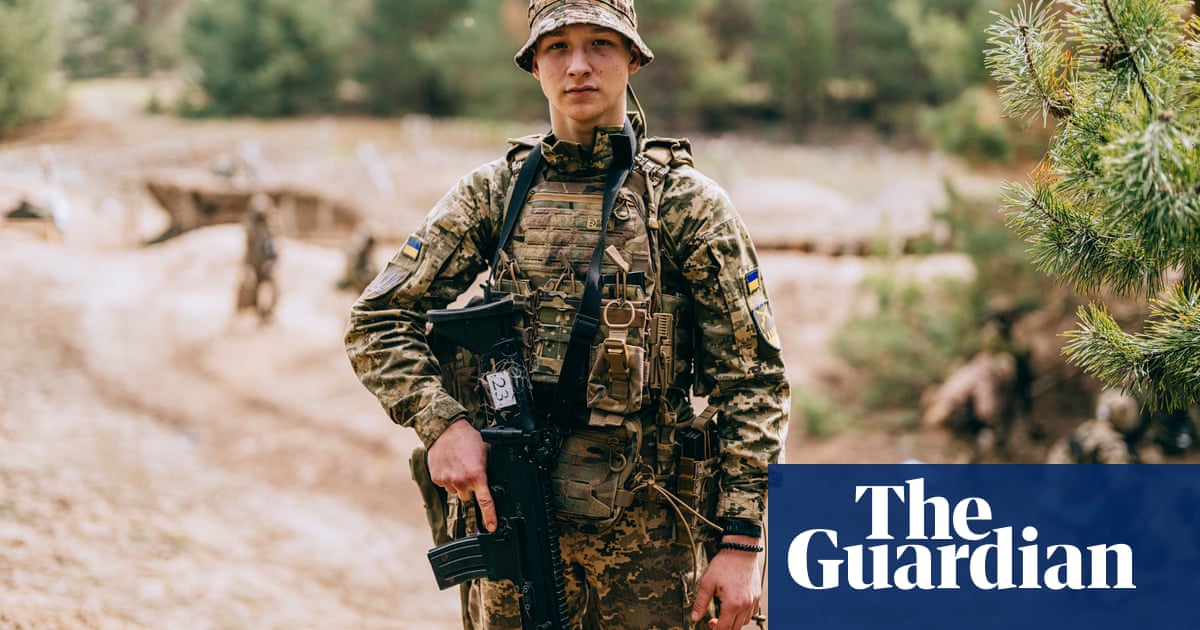“I’m not just here to avenge my brother,” says Luntik, 20, one of Ukraine’s newest soldiers, as he takes a break from training. He has joined up, he says, to try to liberate the territory ofUkrainefrom the Russian invaders: “When the thief is coming to your house and you are afraid he might harm you or kill your wife, you will take actions and, if necessary, kill the thief.”
The mild spring day, somewhere in Kharkiv region, belies the seriousness of the conversation. Luntik is one of a dozen or so young recruits, all aged between 18 and 24, who have agreed to join Ukraine’s army before the age of 25, at which men can be forcibly mobilised. The lure is a bonus of 1m hryvnia (nearly £18,000), 0% mortgages and a short one-year contract; the scheme, launched in February, is a fresh effort to repopulate Ukraine’s frontline.
Luntik is a model recruit for the 92nd brigade, though his family story, like so many others three years into the full-scale Russian invasion, is difficult. His parents died before he grew up and he was raised by foster parents in Lviv. He lost one of his brothers, Serhii, 22, in fighting near Bakhmut earlier in the war, “shot by a bullet in the neck”, but despite this, he says he is not afraid of death. “I didn’t come here to play cat and mouse. I know all the risks. I understand there is a situation where I might not come back” Luntik says.
On today’s frontline, the typical Ukrainian soldier is far older, often in their 40s or 50s, frequently fighting with drones or other technologies that require patience and endurance, not physical strength. For the first two years of the war, the minimum age for potential conscription was 27, the maximum 60. It was lowered to 25, but the Biden and Trump administrations both pressed for it to be lowered to 18, arguing Ukraine was not doing enough to address shortages of personnel.
Though Russia and Ukraine’s armed forces are estimated to be roughly of a similar size – just over 600,000 – the Kremlin can draw on a far larger pool of people, particularly from the country’s poorer regions. Russia’s population, 140.8 million, is roughly four times those remaining in Ukraine (35.6 million). Most of the Ukrainians who were willing to join up and fight did so a long time ago, and many others who have not been drafted would rather leave the country than risk losing their lives in a war that, for all the talk about a ceasefire, continues to grind on.
Though 10,000 young people initially expressed interest, fewer than 500 have signed up,an adviser to Ukraine’s president has said, though a further 1,500 are said to be in the process of doing so. In the past month or so, the country’s best-regarded units have been allowed to recruit young people – “Mum, I joined Azov,” reads a fresh campaign from one – but it is not clear this has much of a positive impact on numbers either, raising the question of why the extra money and short tour of duty has not proved particularly attractive.
Volodymyr is 22, going on 23, he says, and is another of the new recruits. He says he wanted to join the army because “if my children ask me some day: ‘Dad what were you doing during the war?’ I just want to have a proper answer for them. I want them to understand I was defending my country, the same as our fathers.” But he acknowledges that even though he was keen to sign up, it took a while and the new scheme for him to do so.
Before the war, Volodymyr spent time as a DJ between the ages of 16 and 18, followed by a short spell working in construction in Volyn region, which borders Poland to the west. After the full-scale invasion, he signed on for a territorial defence unit based there, but realised there was no prospect of the war coming to his part of the country. Wanting to do more, he tried to join the Third Assault Brigade, but said he was talked out of it by friends. “They said if you go there you might die soon,” and so he hesitated until the new contact offer arrived.
Oleksiy Moskalenko, an analyst at the Come Back Alive foundation, which provides support to Ukraine’s military, said that young people were often subject to a lot of pressure from friends and family, and the long years of war made it clear to people that “it is easy to lose your life”. In February, President Volodymyr Zelenskyy said that 46,000 Ukrainians had been killed and 390,000 wounded and there is no shortage of stories of newly trained soldiers losing their lives within days or weeks of reaching the frontline, sometimes on hopelessly risky missions.
But Moskalenko also argues that “younger people were more disconnected from the public discourse” because blotting out the war in their minds is “a strategy to survive – it’s rational to distance yourself from it”. At a lower intensity, Ukraine’s war with Russia has been running since 2014, he adds, meaning it has always been part of the background of young people’s lives. It helps, he adds, that “it is always an option to hide, to run, or find other ways not to be recruited” – though Ukraine is trying to make it harder for adult men to leave the country.
The young recruits say they are not expecting to be sent to the frontline until June. Luntik will be in a reconnaissance unit, he says, while Volodymyr has been earmarked for a more dangerous infantry role, where combat life expectancy can be short. Both say they expect to rejoin the military after they serve their initial year, albeit after a short break for a holiday.But as Luntik emphasises: “The first thing I need to do is survive.”
